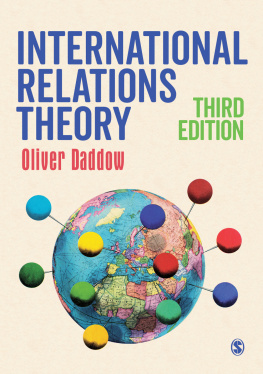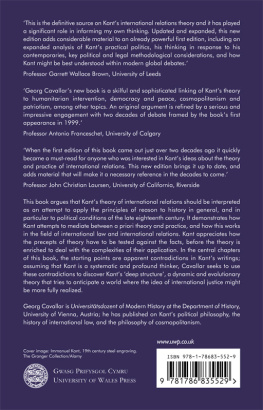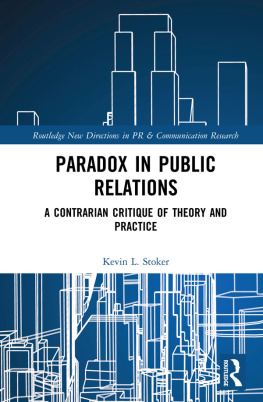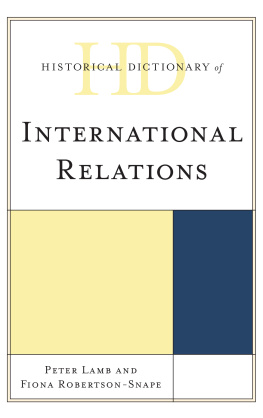BRIDGING
theTHEORY-PRACTICE
DIVIDEinINTERNATIONAL
RELATIONS
BRIDGING
theTHEORY-PRACTICE
DIVIDEinINTERNATIONAL
RELATIONS
DANIEL MALINIAK, SUSAN PETERSON, RYAN POWERS,
andMICHAEL J. TIERNEY,Editors
2020 Georgetown University Press. All rights reserved. No part of this book may be reproduced or utilized in any form or by any means, electronic or mechanical, including photocopying and recording, or by any information storage and retrieval system, without permission in writing from the publisher.
The publisher is not responsible for third-party websites or their content. URL links were active at time of publication.
Library of Congress Cataloging-in-Publication Data
Names: Maliniak, Daniel, editor. | Peterson, Susan, 1961-editor. | Powers, Ryan, editor. | Tierney, Michael J. (Professor of government), editor.
Title: Bridging the Theory-Practice Divide in International Relations/Daniel Maliniak, Susan Peterson, Ryan Powers, Michael J. Tierney.
Description: Washington, DC : Georgetown University Press, 2020. | Includes bibliographical references and index.
Identifiers: LCCN 2019035464 (print) | LCCN 2019035465 (ebook) | ISBN 9781626167810 (hardcover) | ISBN 9781626167827 (paperback) | ISBN 9781626167834 (ebook)
Subjects: LCSH: International relationsStudy and teaching. | International relationsResearch. | International relations specialists.
Classification: LCC JZ1237 .B49 2020 (print) | LCC JZ1237 (ebook) | DDC 327dc23
LC record available at https://lccn.loc.gov/2019035464
LC ebook record available at https://lccn.loc.gov/2019035465

This book is printed on acid-free paper meeting the requirements of the American National Standard for Permanence in Paper for Printed Library Materials.
21 20 9 8 7 6 5 4 3 2 First printing
Printed in the United States of America
Cover design by Jeremy John Parker.
Photo by Nico E. | Unsplash.
CONTENTS
Daniel Maliniak, Susan Peterson, Ryan Powers, and Michael J. Tierney
Amanda Murdie
Sarah E. Mendelson
Jessica F. Green and Thomas Hale
Marc A. Levy
Christina J. Schneider
Steven Radelet
Edward D. Mansfield and Jon C. W. Pevehouse
Robert B. Zoellick
Thomas B. Pepinsky and David A. Steinberg
Dimitri G. Demekas
Sarah Kreps and Jessica Weeks
Peter D. Feaver
Michael G. Findley and Joseph K. Young
Scott Edwards
Paul C. Avey and Michael C. Desch
John R. Harvey
Daniel Maliniak, Susan Peterson, Ryan Powers, and Michael J. Tierney
ILLUSTRATIONS
FIGURES
TABLES
ACKNOWLEDGMENTS
In many ways this book traces its origins to a series of conversations between faculty and students at William & Mary more than fifteen years ago. The students routinely pushed the faculty to think more deeply about our discipline and our place in it. They asked why political scientists seemed to write exclusively for others in the field and to teach their students to do the same. They repeatedly asked that their coursework (and related research opportunities) be more closely linked to the practice of international relations (IR). They asked good, smart questions: Why do professors spend so much time in class teaching us about structural realism and the various flavors of constructivism? How will this help us to do better work at the State Department, World Bank, or Amnesty International after we graduate? Does any of the research done in the IR field actually shape the thinking and behavior of policymakers? What else should we study, other than political science, to affect outcomes in the real world?
We did not always have good answers to these questions because our answers were rooted in anecdotes and second-hand observations. We had plenty of theory and good evidence about war, trade, human rights, and foreign aid, but we lacked theory and good evidence about our own discipline, which are necessary conditions for social scientific inference. To address any of these questions in a serious way, we would need a more systematic approach to studying the teaching and research practices of IR scholars and we would need data on what practitioners find most useful from their counterparts in the academy.
The Teaching, Research and International Policy (TRIP) Project grew out of those early conversations, which continued at William & Mary and, later, at the University of California, San Diego (UCSD) and the University of Wisconsin, as Dan and Ryan continued their studies. For many years, we focused most of our efforts at TRIP on disciplinary questions about the paradigmatic commitments, methodological choices, and substantive focus of IR scholars, using both surveys and content analysis of peer-reviewed journal articles.
With this book we come full circle, returning to our early conversations about the relevance of the IR discipline to the real world of international politics. This volume emerged from long-running conversations among the four of us, and with colleagues and students, about how the data we had gathered and produced on the IR discipline might speak to growing concerns about the divide between scholars and practitioners. We sought to describe and explain what many thought was a growing gap between the theory and practice of IR. Others in the discipline made a similar turn, doing the important work of trying to close this gap, particularly in the area of national security policy. Our efforts, in contrast, have focused on more fully characterizing the divide empirically and, crucially, identifying the structural forces that cause the divide and cause it to vary in magnitude over time and across issue areas. This book is a result of those efforts.
This book brings together twenty-six scholars and practitioners to explore the nature and extent of the gap across eight IR subfields: human rights, the environment, foreign aid and development, international trade, money and finance, intrastate conflict and terrorism, interstate war, and nuclear strategy. Even though this is not a book about how to bridge the gap between scholars and practitioners, we engage in a bit of bridge building of our own: we bring leading IR scholars into direct conversations with a wide range of policy practitioners. The result is a first-of-its-kind assessment of the theory-practice divide in IR that includes perspectives not only from both sides of the divide but also across a range of substantive issue areas. We hope the book itself makes a contribution to our understanding of the relationship between the theory and practice of international relations, but we are even more confident that the publicly accessible datasets on which this book is based, and which are now publicly available for other scholars to use, will make a greater long-term contribution to our understanding of the IR discipline and its interaction with the policy world.











 This book is printed on acid-free paper meeting the requirements of the American National Standard for Permanence in Paper for Printed Library Materials.
This book is printed on acid-free paper meeting the requirements of the American National Standard for Permanence in Paper for Printed Library Materials.